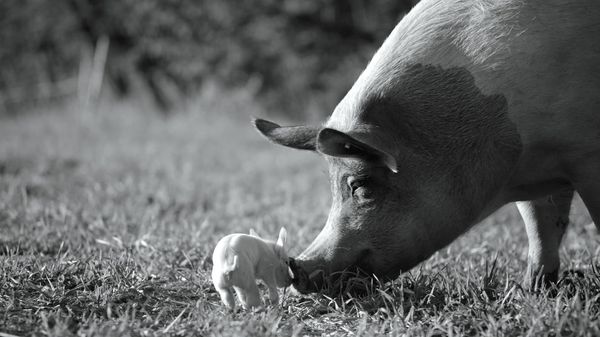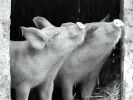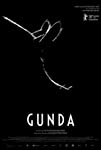Eye For Film >> Movies >> Gunda (2020) Film Review
Gunda
Reviewed by: Anne-Katrin Titze

Gunda is an extraordinarily impactful, loving, and urgent film and the more people stumble upon it, because they are lured by a magnificent pig with the cutest piglets, shot in poised black and white, the better off they will be.
Victor Kossakovsky’s film, co-written with Ainara Vera, is executive produced by Joaquin Phoenix, co-produced by Anita Rehoff Larsen from Sant & Usant with Joslyn Barnes and Susan Rockefeller of Louverture Films (Nadine Labaki's Capernaum, Yance Ford's Strong Island, RaMell Ross's Hale County This Morning, This Evening) and a Main Slate selection of the 58th New York Film Festival, after it had its world premiere at the Berlin Film Festival.

We meet Gunda, it seems, while she is giving birth to her 13 piglets. The camera stays respectfully outside the small barn structure at first. A bit later we get very very close - one of the newborns is still wet - and we see what Gunda has to do to keep everything under control. We see them sleep, huddled together, and feed and play. Watching them makes you think of life and death and how absolutely wondrous it is that we are here. Piglets, hay, mud, me writing this, you reading this review, the sky above, the earth below. Kossakovsky brings us to what it’s actually all about. And we play a part in it, daily, with our decisions for every meal.
There is Gunda in profile, the light carves her out in silhouette, like Alfred Hitchcock, watching over her new family in action at the farm. Some are shivering, some squealing, some tails already curly, others still straight. A cuckoo is heard in the distance. There is no narration, no text on the screen and you don’t miss them for a second. The language captured here speaks volumes. The animals’ faces, their reactions and movements, remind doubters of their sentient nature in every shot.
A crate with roosters, who clearly had had a tough life beforehand, is placed in a meadow. One of them opens the gate, cautiously, gently. This is new territory for them. The heedful steps - chicken feet seen in close closeups - are those of prisoners, torture victims perhaps, who haven’t experienced sunshine and freedom and soil and grass for a long time, maybe never. This must have been filmed in a sanctuary. Although the locations are different farms and sanctuaries in different countries, the film does not distinguish them, as this is besides the point.
One rooster looks up hearing a bird sound. Remember the world around you? There are sheep sounds as we follow a one-legged rooster on his tour of discovery. He is a fighter, jumping over obstacles.
Gunda’s piglets, now a bit bigger, also carefully listen to the sounds outside and hesitate before taking a walk through the forest with mom. One has a bad leg and Gunda nudges the little one on, highly aware that help might be needed. A woodpecker works on a tree as we learn about piglet dynamics. So small, their faces already show individual personality traits. Mooing is heard, while the image still rests on long white piglet eyelashes, for an audio-segue to a herd of cows, running exuberantly like children at recess. Off they go, jumping up and down, racing to an area with tall grasses where they all start sounding off at the same time.
The cow segment is just as magnificent and finely observed and full of discovery as the pig and rooster ones are. Old wizened bovine faces look straight into the camera and into our soul. There are a lot of flies around them and they have come up with a remarkable heads and tails solution that demands teamwork and coordination.
It is no coincidence that Kossakovsky chose these specific farm animals as protagonists for his film. In a beautiful and little known tale collected by the Brothers Grimm, called The House in the Forest a “pretty hen, pretty rooster, and pretty spotted cow” are catalyst characters, showing what the humans are made of by how they treat them. And this is the point. When Gunda looks out at her children playing in the yard and you are reminded of your own grandmother, this does not mean you anthropomorphise anything, you simply see the fact of our similarity.
The camera often places us among the piglets; some of them give their mother a little thank-you lick after lunch. I did not expect to have to think so much of Claude Lanzmann’s films while watching Gunda. The piglets we got to know a little come out to catch some raindrops in their open mouths. Then they nap. Without showing any images of mass farming or slaughter instruments, Gunda sends a most forceful message about gratitude, respect and humility and the horrors that humans unleash on the world everyday, every hour, becoming complicit in every meal where convenience is king.
In 2020 we know more than ever before about conditions at wet markets and processing plants all over the world, not far away at all, that deliver cheap meat and poultry, packaged up in plastic to make it least resemble a living soul with a face and a heart. It’s time to stop pretending.
Reviewed on: 17 Sep 2020















